Doubly Linked list
 Anushka Joshi
Anushka JoshiA doubly linked list (DLL) is a type of linked list where each node has a pointer to both the previous node and the next node.
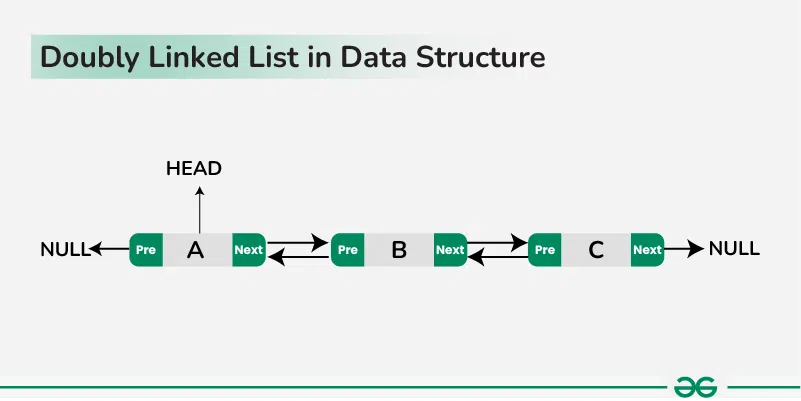
| SN | Operation | Description |
| 1 | Insertion at beginning | Adding the node into the linked list at beginning. |
| 2 | Insertion at end | Adding the node into the linked list to the end. |
| 3 | Insertion after specified node | Adding the node into the linked list after the specified node. |
| 4 | Deletion at beginning | Removing the node from beginning of the list |
| 5 | Deletion at the end | Removing the node from end of the list. |
| 6 | Deletion of the node having given data | Removing the node which is present just after the node containing the given data. |
| 7 | Searching | Comparing each node data with the item to be searched and return the location of the item in the list if the item found else return null. |
| 8 | Traversing | Visiting each node of the list at least once in order to perform some specific operation like searching, sorting, display, etc. |
Standard Operations on Doubly Linked Lists in Data Structures
Insertion
Adding a node to a doubly linked list is similar to adding a node to a linked list. The only extra work is handling the pointer to the previous node. It is faster than linked lists because we just need to change the pointers of the adjacent elements of the element we are inserting..
Generalized Algorithm for Insertion in a Doubly Linked List
Step 1: Create a new node with the given data.
Step 2: If the doubly linked list is empty:
i. Set the head and tail pointers point to the new node.
ii. make the new node's prev and next pointers point to NULL.
Step 3: If the doubly linked list is not empty:
i. Perform the insertion as per your requirement, either in the beginning, end, or at a given position.

In the given doubly linked list, insertion can be done in three ways:
Insertion at the beginning: Here, we insert the new node before the
headnode, and theheadpoints to the new node.Let's understand this with an example. Suppose we want to insert a node with value
6at the beginning of the doubly linked list. Follow these steps:Create a new node
Allocate memory for the new node.
Assign the
datato the new node.
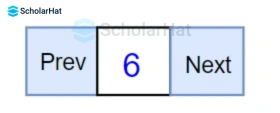
Set
prevandnextpointers of the new nodepoint
nextof new Node to thefirstnode of the doubly linked listpoint
prevtoNULL
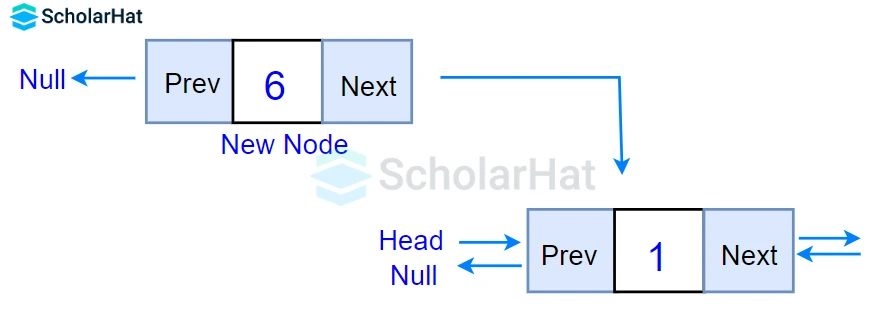
Make new node the
headnodePoint
prevof the first node to new Node (now the previous head is the second node)Point
headto new Node

The above-given steps are implemented in the below program
Example of Insertion at the Beginning of a Doubly Linked List
class Node:
def __init__(self, data):
self.data = data
self.prev = None
self.next = None
class DoublyLinkedList:
def __init__(self):
self.head = None
# Function to insert a node at the front of the doubly linked list
def insert_front(self, data):
# Allocate memory for newNode
new_node = Node(data)
# Point next of newNode to the first node of the doubly linked list
new_node.next = self.head
# Point prev to None
new_node.prev = None
# Point previous of the first node (now the first node is the second node) to newNode
if self.head is not None:
self.head.prev = new_node
# Head points to newNode
self.head = new_node
# Function to print the elements of the doubly linked list
def print_list(self):
current = self.head
while current:
print(current.data, end=" ")
current = current.next
print()
# Creating a sample doubly linked list with nodes 1, 2, 3
my_list = DoublyLinkedList()
my_list.head = Node(1)
second = Node(2)
third = Node(3)
my_list.head.next = second
second.prev = my_list.head
second.next = third
third.prev = second
print("Original list:", end=" ")
my_list.print_list()
# Inserting node with data 6 at the front
my_list.insert_front(6)
print("List after inserting node with data 6 in the beginning:", end=" ")
my_list.print_list()
Run Code >>
Output
Original list: 1 2 3
List after inserting node with data 6 in the beginning: 6 1 2 3
Insertion at a specific position/in between the nodes: Suppose we need to insert a node at the position of
Node X. The steps are:Traverse the doubly linked list to
Node X.Change the
nextpointer of the new node to thenextpointer ofNode X.Change the
prevpointer of the node followingNode Xto the new node.Change the
nextpointer ofNode Xto the new node.Change the
prevpointer of the new node toNode X.
Let's understand this with an example. Suppose we want to insert a node with value 6 after the second node with value 2 in the doubly linked list. Here are the steps:
Create a new node
Allocate memory for the new node.
Assign the
datato the new node.
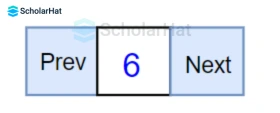
Set the
nextpointer of the new node and the previous node.assign the value of
nextfrom the previous node to thenextof new Node.assign the address of the new Node to the
nextof the previous node.
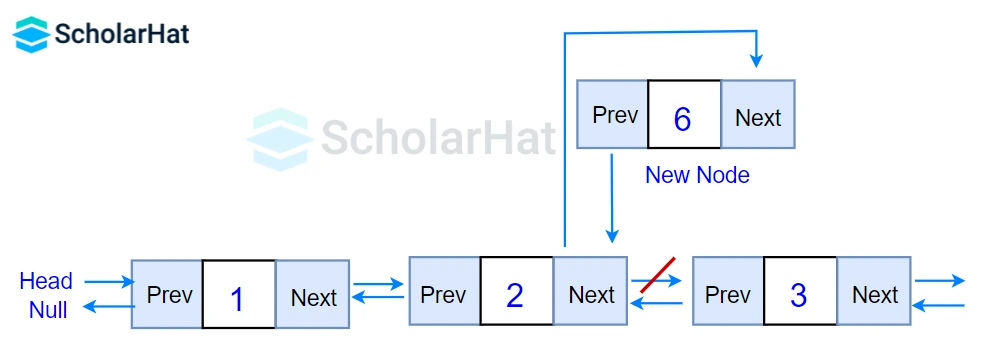
Set the
prevpointer ofnewnode and thenextnode.assign the value of
prevof next node to theprevof new Node.assign the address of the new Node to the
prevof next node

The final doubly linked list after this insertion is:

Example of Insertion in Between or at a Given Position in a Doubly Linked List
class Node:
def __init__(self, val):
self.data = val
self.prev = None
self.next = None
class DoublyLinkedList:
def __init__(self):
self.head = None
# Function to insert a node after a specific node
def insert_after(self, prev_node, data):
# Check if the previous node is None
if prev_node is None:
print("Previous node cannot be None")
return
# Allocate memory for newNode
new_node = Node(data)
# Set next of newNode to next of prev node
new_node.next = prev_node.next
# Set next of prev node to newNode
prev_node.next = new_node
# Set prev of newNode to the previous node
new_node.prev = prev_node
# Set prev of newNode's next to newNode
if new_node.next is not None:
new_node.next.prev = new_node
# Function to print the elements of the doubly linked list
def print_list(self):
current = self.head
while current is not None:
print(current.data, end=" ")
current = current.next
print()
# Creating a sample doubly linked list
my_list = DoublyLinkedList()
my_list.head = Node(1)
second = Node(2)
third = Node(3)
my_list.head.next = second
second.prev = my_list.head
second.next = third
third.prev = second
print("Original list:", end=" ")
my_list.print_list()
# Inserting a node with data 6 after the second node (with data 2)
my_list.insert_after(second, 6)
print("List after inserting node with data 6 after node with data 2:", end=" ")
my_list.print_list()
Run Code >>
Output
Original list: 1 2 3
List after inserting node with data 6 after node with data 2: 1 2 6 3
Insertion at the end: Here, we add the new node at the end of the list, after the
tailnode, and thetailthen points to the new node.Let's understand this with an example. Suppose we want to add a node with value
6at the end of the given doubly linked list. We can do this in two steps:Create a new node
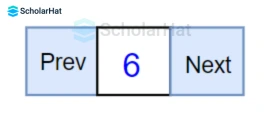
Set
prevandnextpointers of the new node and the previous node If the linked list is empty, make the new Node as theheadnode. Otherwise, traverse to the end of the doubly linked list.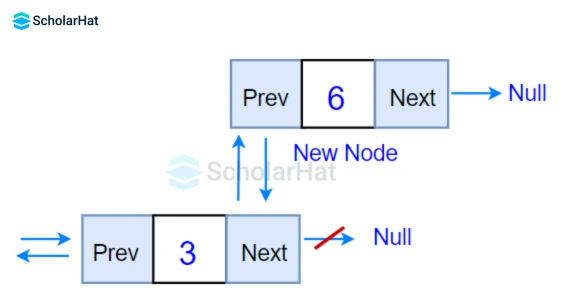
The final doubly linked list after this insertion is:

Example of Insertion at the End of a Doubly Linked List
class Node:
def __init__(self, val):
self.data = val
self.prev = None
self.next = None
class DoublyLinkedList:
def __init__(self):
self.head = None
# Function to insert a new node at the end of the list
def insert_end(self, data):
# Allocate memory for node
new_node = Node(data)
# Assign NULL to next of new_node
new_node.next = None
# Store the head node temporarily (for later use)
temp = self.head
# If the linked list is empty, make the new_node as the head node
if self.head is None:
new_node.prev = None
self.head = new_node
return
# If the linked list is not empty, traverse to the end of the linked list
while temp.next is not None:
temp = temp.next
# Now, the last node of the linked list is temp
# Point the next of the last node (temp) to new_node.
temp.next = new_node
# Assign prev of new_node to temp
new_node.prev = temp
# Function to print the elements of the doubly linked list
def print_list(self):
current = self.head
while current is not None:
print(current.data, end=" ")
current = current.next
print()
# Creating a sample doubly linked list with values 1, 2, 3
my_list = DoublyLinkedList()
my_list.head = Node(1)
second = Node(2)
third = Node(3)
my_list.head.next = second
second.prev = my_list.head
second.next = third
third.prev = second
print("Original list:", end=" ")
my_list.print_list()
# Inserting node with value 6
my_list.insert_end(6)
# Printing the updated list
print("List after inserting node 6 at the end:", end=" ")
my_list.print_list()
Deletion
Similar to Insertion, deletion in a Doubly Linked List is also fast. It can be done by just changing the pointers of its adjacent Nodes.

In the above given doubly linked list, deletion can also be done in three ways:
Deletion at the beginning: To delete the first node, we move the
headto the next node and set the previous pointer of the newheadtoNULL.Let's see an example. Suppose we want to delete the first node with the value 1 in the given doubly linked list. Here are the steps:
- Set the new head to the node after the node to be deleted (i.e., node two).

free the memory of
del_node. And, the linked list will look like this:
The above-given steps are implemented in the below program
Example of Deletion of the First Node of a Doubly Linked List
class Node:
def __init__(self, val):
self.data = val
self.prev = None
self.next = None
class DoublyLinkedList:
def __init__(self):
self.head = None
# Function to delete a node from the doubly linked list
def delete_node(self, del_node):
# Check if del_node is the head of the linked list
if self.head == del_node:
self.head = del_node.next
# Update the next pointer of the previous node (if del_node is not the head)
if del_node.prev is not None:
del_node.prev.next = del_node.next
# Update the prev pointer of the next node (if del_node is not the last node)
if del_node.next is not None:
del_node.next.prev = del_node.prev
# Free the memory allocated for del_node (Python automatically handles memory)
# Function to print the elements of the doubly linked list
def print_list(self):
current = self.head
while current is not None:
print(current.data, end=" ")
current = current.next
print()
# Creating a sample doubly linked list with values 1, 2, 3
my_list = DoublyLinkedList()
my_list.head = Node(1)
second = Node(2)
third = Node(3)
my_list.head.next = second
second.prev = my_list.head
second.next = third
third.prev = second
print("Original list:", end=" ")
my_list.print_list()
# Deleting the head node (with data 1) from the list
my_list.delete_node(my_list.head)
print("List after deleting the head node with data 1:", end=" ")
my_list.print_list()
Deleting a node at a specific position: To remove a node from a specific spot in the list, you need to go through the list until you reach that spot. Let's call the node before the one you want to delete
Node Xand the node after itNode Y. Here are the steps:Change the
nextpointer ofNode Xto point toNode Y.Change the
prevpointer ofNode Yto point toNode X.
Let's understand this with an example. Suppose we want to delete the second node with value 2 after the first node with value 1 in the given doubly linked list. Here are the steps:
For the node before the
del_node(i.e., the first node):- Set the
nextof the first node to thenextof thedel_node.
- Set the
For the node after the
del_node(i.e., the third node):- Set the
prevof the third node to theprevof thedel_node.
- Set the

Finally, we will free the memory of
del_node. And, the final doubly linked list looks like this.
The above-given steps are implemented in the below program
Example of Deletion of an Inner Node in Between the Doubly Linked List
class Node:
def __init__(self, val):
self.data = val
self.prev = None
self.next = None
class DoublyLinkedList:
def __init__(self):
self.head = None
# Function to remove a node from the doubly linked list
def remove_node(self, del_node):
if del_node.next is not None:
del_node.next.prev = del_node.prev
if del_node.prev is not None:
del_node.prev.next = del_node.next
# Optionally free the memory of the deleted node
del_node = None
# Function to print the elements of the doubly linked list
def print_list(self):
current = self.head
while current is not None:
print(current.data, end=" ")
current = current.next
print()
# Creating a sample doubly linked list
my_list = DoublyLinkedList()
my_list.head = Node(1)
second = Node(2)
third = Node(3)
my_list.head.next = second
second.prev = my_list.head
second.next = third
third.prev = second
print("Original list:", end=" ")
my_list.print_list()
# Removing the second node (with data 2) from the list
my_list.remove_node(second)
print("List after removing node with data 2:", end=" ")
my_list.print_list()
Deletion at the end: Here we will move the
tailto the previous node to delete the node at the end and make thenextpointer of thetailnode point toNULL.Let us understand this with an illustration. Suppose we want to delete the last node with the value 3 at the end of the given doubly linked list.
delete the
del_nodeand make thenextof node beforedel_nodepoint toNULL.
The final doubly linked list looks like this.
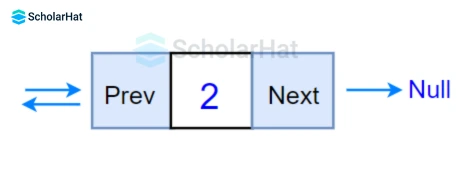
Example of Deletion of the Last Node of Doubly Linked List
class Node:
def __init__(self, val):
self.data = val
self.prev = None
self.next = None
class DoublyLinkedList:
def __init__(self):
self.head = None
# Function to delete the last node from the doubly linked list
def delete_last_node(self):
# Check if the linked list is empty
if self.head is None:
print("List is empty. Cannot delete last node.")
return
# Traverse to the last node
temp = self.head
while temp.next is not None:
temp = temp.next
# Check if the list has only one node
if temp.prev is None:
self.head = None # Set head to None as the list is now empty
else:
# Update the next pointer of the previous node to None
temp.prev.next = None
# Function to print the elements of the doubly linked list
def print_list(self):
current = self.head
while current is not None:
print(current.data, end=" ")
current = current.next
print()
# Creating a sample doubly linked list with values 1, 2, 3
my_list = DoublyLinkedList()
my_list.head = Node(1)
second = Node(2)
third = Node(3)
my_list.head.next = second
second.prev = my_list.head
second.next = third
third.prev = second
print("Original list:", end=" ")
my_list.print_list()
# Deleting the last node from the list
my_list.delete_last_node()
print("List after deleting the last node:", end=" ")
my_list.print_list()
Traversal
You can move through the doubly linked list in both directions. You can go to the previous node using the previous pointers and go to the next nodes using the next pointers. This allows you to do tasks like searching, sorting, and displaying the list.
Algorithm for Traversing a Doubly Linked List
Step 1. Set a pointer current to the head of the doubly linked list.
Step 2. If the doubly linked list is empty (i.e., current is null), then the traversal is complete.
Step 3. While the current pointer is not null:
a. Process the data of the current node.
b. Move the current pointer to the next node (current = current->next).
or
b. Move the 'current' pointer to the previous node (current = current->prev)
Step 4. The traversal is complete when the 'current' pointer becomes null.
class Node:
def __init__(self, val):
self.value = val
self.previous = None
self.next = None
class DoublyLinkedList:
def traverse_forward(self, start):
current = start
# Checks whether the list is empty
if start is None:
print("Node to start from is NULL")
return
while current is not None:
print("Node:", current.value)
current = current.next
def traverse_backward(self, start):
current = start
# Checks whether the list is empty
if start is None:
print("Node to start from is NULL")
return
while current is not None:
print("Node:", current.value)
current = current.previous
# Creating a sample doubly linked list
first = Node(1)
second = Node(2)
third = Node(3)
first.next = second
second.previous = first
second.next = third
third.previous = second
my_list = DoublyLinkedList()
print("Traversing forward:")
my_list.traverse_forward(first)
print("Traversing backward:")
my_list.traverse_backward(third)
Search
To search in the given doubly linked list, we need to go through the list starting from the first node and keep moving to the next nodes using the next pointer. We can compare each visited element with the one we are looking for.
Step 1. Start with a pointer current at the head of the doubly linked list.
Step 2. If the doubly linked list is empty (i.e., current is null), the value is not found.
Step 3. While the current pointer is not null:
a. Check if the data in the current node is equal to the target value.
- If yes, the value is found, and you can return the node or its position.
b. Move the current pointer to the next node (current = current->next).
Step 4. If the current pointer becomes null and the value is not found, then the value is not present in the list.
class Node:
def __init__(self, val):
self.value = val
self.next = None
class LinkedList:
def __init__(self):
self.head = None
def search_node(self, value):
i = 1
# Node current will point to head
current = self.head
# Checks whether the list is empty
if self.head is None:
print("List is empty")
return
# Traversing the List.
while current is not None:
# Compare value to be searched with each node in the list
if current.value == value:
print(f"Node {value} is present in the list at the position: {i}")
return
current = current.next
i += 1
print(f"Node {value} is not present in the list")
# Creating a sample linked list
my_list = LinkedList()
my_list.head = Node(7)
my_list.head.next = Node(8)
my_list.head.next.next = Node(9)
my_list.head.next.next.next = Node(4)
# Searching for a node in the linked list
my_list.search_node(8)
my_list.search_node(6)
Complexity Analysis of Doubly Linked List Operations
| Operations | Time Complexity | Space Complexity |
| Insertion at the beginning | O(1) | O(1) |
| Insertion at a specific position | O(n) | O(1) |
| Insertion at the end | O(1) | O(1) |
| Deletion at the beginning | O(1) | O(1) |
| Deletion at a specific position | O(n) | O(1) |
| Deletion at the end | O(1) | O(1) |
| Traversal | O(n) | O(1) |
| Search | O(n) | O(1) |
Singly Linked List Vs Doubly Linked List
| Singly linked list (SLL) | Doubly Linked List (DLL) |
| SLL nodes contain 2 fields -the data field and the next link field. | DLL nodes contain 3 fields - the data field, a previous link field, and a next link field. |
| In SLL, the traversal can be done using the next node link only. Thus traversal is possible in one direction only. | In DLL, the traversal can be done using the previous node-link or the next node link. Thus traversal is possible in both directions (forward and backward). |
| The SLL occupies less memory than DLL as it has only 2 fields. | The DLL occupies more memory than SLL as it has 3 fields. |
| The complexity of insertion and deletion at a given position is O(n). | The complexity of insertion and deletion at a given position is O(n / 2) = O(n) because traversal can be made from the start or the end. |
| Complexity of deletion with a given node is O(n), because the previous node needs to be known, and traversal takes O(n) | Complexity of deletion with a given node is O(1) because the previous node can be accessed easily |
| We mostly prefer to use singly linked list for the execution of stacks. | We can use a doubly linked list to execute heaps, stacks, binary trees, etc. |
| When we do not need to perform any searching operation and we want to save memory, we prefer a singly linked list. | In case of better implementation, while searching, we prefer to use a doubly linked list. |
| A singly linked list consumes less memory as compared to a doubly linked list. | The doubly linked list consumes more memory as compared to the singly linked list. |
| It is less efficient as compared to a doubly-linked list. | It is more efficient. |
Advantages of Doubly LinkedList over thesingly linked list:
A DLL can be traversed in both forward and backward directions.
The delete operation in a DLL is more efficient if a pointer to the node to be deleted is given.
We can quickly insert a new node before a given node.
In a singly linked list, to delete a node, a pointer to the previous node is needed. To get this previous node, sometimes the list is traversed. In a DLL, we can get the previous node using the previous pointer.
Disadvantages of Doubly LinkedList over the singly linked list:
Every node of a DLL needs extra space for a previous pointer. It is possible to implement a DLL with a single pointer though .
All operations need an extra previous pointer to be maintained. For example, in insertion, we need to update previous pointers along with the next pointers. In the following functions for insertions at different positions, we need 1 or 2 extra steps to set the previous pointer.
Subscribe to my newsletter
Read articles from Anushka Joshi directly inside your inbox. Subscribe to the newsletter, and don't miss out.
Written by
